BUMGT5980 Managerial Decision Making: Bias Concepts & Case Studies
VerifiedAdded on 2023/04/26
|12
|4379
|264
Essay
AI Summary
This essay critically examines the concept of bias in managerial decision-making, drawing upon Herbert A. Simon's quote about the limitations of human rationality. It explores three key concepts: bounded awareness, framing, and emotional bias, explaining how each can lead to flawed decisions. Bounded awareness refers to the failure to recognize relevant information due to focus on other issues. Framing explores how the presentation of options (positive or negative) influences choices. Emotional bias highlights how emotions like sadness, fear, or overconfidence distort judgment. The essay further illustrates these concepts with real-world scenarios, including the case of Merck's Vioxx drug recall, demonstrating how these biases manifest in practical situations and affect outcomes. The document is available on Desklib, a platform offering study tools and resources for students.

Running Head: Managerial Decision Making
Managerial Decision Making
Essay
System04104
4/2/2019
Managerial Decision Making
Essay
System04104
4/2/2019
Paraphrase This Document
Need a fresh take? Get an instant paraphrase of this document with our AI Paraphraser
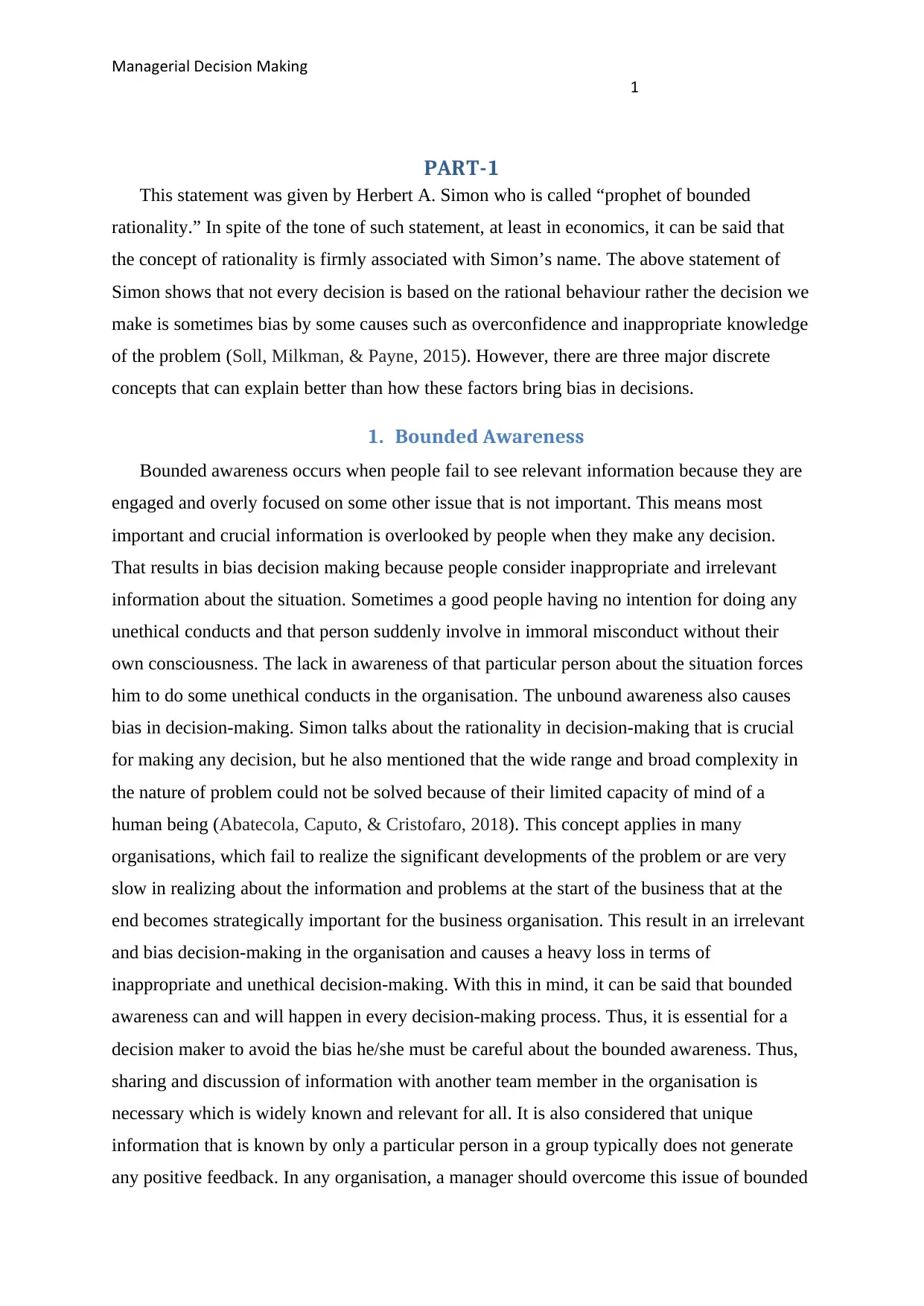
Managerial Decision Making
1
PART-1
This statement was given by Herbert A. Simon who is called “prophet of bounded
rationality.” In spite of the tone of such statement, at least in economics, it can be said that
the concept of rationality is firmly associated with Simon’s name. The above statement of
Simon shows that not every decision is based on the rational behaviour rather the decision we
make is sometimes bias by some causes such as overconfidence and inappropriate knowledge
of the problem (Soll, Milkman, & Payne, 2015). However, there are three major discrete
concepts that can explain better than how these factors bring bias in decisions.
1. Bounded Awareness
Bounded awareness occurs when people fail to see relevant information because they are
engaged and overly focused on some other issue that is not important. This means most
important and crucial information is overlooked by people when they make any decision.
That results in bias decision making because people consider inappropriate and irrelevant
information about the situation. Sometimes a good people having no intention for doing any
unethical conducts and that person suddenly involve in immoral misconduct without their
own consciousness. The lack in awareness of that particular person about the situation forces
him to do some unethical conducts in the organisation. The unbound awareness also causes
bias in decision-making. Simon talks about the rationality in decision-making that is crucial
for making any decision, but he also mentioned that the wide range and broad complexity in
the nature of problem could not be solved because of their limited capacity of mind of a
human being (Abatecola, Caputo, & Cristofaro, 2018). This concept applies in many
organisations, which fail to realize the significant developments of the problem or are very
slow in realizing about the information and problems at the start of the business that at the
end becomes strategically important for the business organisation. This result in an irrelevant
and bias decision-making in the organisation and causes a heavy loss in terms of
inappropriate and unethical decision-making. With this in mind, it can be said that bounded
awareness can and will happen in every decision-making process. Thus, it is essential for a
decision maker to avoid the bias he/she must be careful about the bounded awareness. Thus,
sharing and discussion of information with another team member in the organisation is
necessary which is widely known and relevant for all. It is also considered that unique
information that is known by only a particular person in a group typically does not generate
any positive feedback. In any organisation, a manager should overcome this issue of bounded
1
PART-1
This statement was given by Herbert A. Simon who is called “prophet of bounded
rationality.” In spite of the tone of such statement, at least in economics, it can be said that
the concept of rationality is firmly associated with Simon’s name. The above statement of
Simon shows that not every decision is based on the rational behaviour rather the decision we
make is sometimes bias by some causes such as overconfidence and inappropriate knowledge
of the problem (Soll, Milkman, & Payne, 2015). However, there are three major discrete
concepts that can explain better than how these factors bring bias in decisions.
1. Bounded Awareness
Bounded awareness occurs when people fail to see relevant information because they are
engaged and overly focused on some other issue that is not important. This means most
important and crucial information is overlooked by people when they make any decision.
That results in bias decision making because people consider inappropriate and irrelevant
information about the situation. Sometimes a good people having no intention for doing any
unethical conducts and that person suddenly involve in immoral misconduct without their
own consciousness. The lack in awareness of that particular person about the situation forces
him to do some unethical conducts in the organisation. The unbound awareness also causes
bias in decision-making. Simon talks about the rationality in decision-making that is crucial
for making any decision, but he also mentioned that the wide range and broad complexity in
the nature of problem could not be solved because of their limited capacity of mind of a
human being (Abatecola, Caputo, & Cristofaro, 2018). This concept applies in many
organisations, which fail to realize the significant developments of the problem or are very
slow in realizing about the information and problems at the start of the business that at the
end becomes strategically important for the business organisation. This result in an irrelevant
and bias decision-making in the organisation and causes a heavy loss in terms of
inappropriate and unethical decision-making. With this in mind, it can be said that bounded
awareness can and will happen in every decision-making process. Thus, it is essential for a
decision maker to avoid the bias he/she must be careful about the bounded awareness. Thus,
sharing and discussion of information with another team member in the organisation is
necessary which is widely known and relevant for all. It is also considered that unique
information that is known by only a particular person in a group typically does not generate
any positive feedback. In any organisation, a manager should overcome this issue of bounded

Managerial Decision Making
2
awareness in their organisational decision-making because it is always lead to the bias
decision making (Peters, Evans, Hemmerich, & Berman, 2016). A manager should also try to
identify the relevant information that is essential and required in making the decision and get
it, rather than depends on using the pre-collected information or information that is already
available in the room.
Simons told in his statement that it is nature of human mind that it is characteristically
unable to sighted certain things but because they humans are limited by the extent in their
own imagination, it is difficult for us to imagine what is not exist in that particular situation
or problem (Andia & Chorev, 2017). Because of some blind spots in the human mind and
limited capacity of it, we miss things, then after our mind replaces what we did not see with
what it expects to experience. It can be explained in many studies that unexpected and hide
information is particularly easy to miss. Thus, to avoid such circumstances of bias decision-
making because of unbounded awareness, an organisation should focus on silos and multi-
layer of management hinder information flow. With this strategy, the information is not
transmitted well across silos, and the multiple layers of management can filter the
information that is not relevant in the decision-making.
2. Framing
The framing effect is a cognitive bias where people make their decision based on options
if the options are based on positive or negative consequences such as loss or gain. In other
words, the framing concept depends on how the brain makes decisions about information
depending on how the information is presented. The framing effect constantly recognized as
one of the strongest biases in making decisions. Framing can be used in many ways such as
from emotional appeals to social pressure to priming etc. it has been observed that people
normally avoid risk when they consider that there is positive frame is presented in the
decision-making, but seek risks when they observe a negative frame is presented (Bachkirov,
2015). The concept helps in to develop an understanding of the different frames available in
the decision-making process. The understanding of framing concept in decision-making
avoids the bias while making any decision. Prospect theory was the first theoretical
explanation of framing concept that was given by Kahneman and Tversky in 1979. This
theory supports the rational decision making of Simon and reveals the people who would not
compliment completely rational action always refers to deviates the rationality. This theory
focuses on two stages called editing and evaluation. In the editing stage, people normally
2
awareness in their organisational decision-making because it is always lead to the bias
decision making (Peters, Evans, Hemmerich, & Berman, 2016). A manager should also try to
identify the relevant information that is essential and required in making the decision and get
it, rather than depends on using the pre-collected information or information that is already
available in the room.
Simons told in his statement that it is nature of human mind that it is characteristically
unable to sighted certain things but because they humans are limited by the extent in their
own imagination, it is difficult for us to imagine what is not exist in that particular situation
or problem (Andia & Chorev, 2017). Because of some blind spots in the human mind and
limited capacity of it, we miss things, then after our mind replaces what we did not see with
what it expects to experience. It can be explained in many studies that unexpected and hide
information is particularly easy to miss. Thus, to avoid such circumstances of bias decision-
making because of unbounded awareness, an organisation should focus on silos and multi-
layer of management hinder information flow. With this strategy, the information is not
transmitted well across silos, and the multiple layers of management can filter the
information that is not relevant in the decision-making.
2. Framing
The framing effect is a cognitive bias where people make their decision based on options
if the options are based on positive or negative consequences such as loss or gain. In other
words, the framing concept depends on how the brain makes decisions about information
depending on how the information is presented. The framing effect constantly recognized as
one of the strongest biases in making decisions. Framing can be used in many ways such as
from emotional appeals to social pressure to priming etc. it has been observed that people
normally avoid risk when they consider that there is positive frame is presented in the
decision-making, but seek risks when they observe a negative frame is presented (Bachkirov,
2015). The concept helps in to develop an understanding of the different frames available in
the decision-making process. The understanding of framing concept in decision-making
avoids the bias while making any decision. Prospect theory was the first theoretical
explanation of framing concept that was given by Kahneman and Tversky in 1979. This
theory supports the rational decision making of Simon and reveals the people who would not
compliment completely rational action always refers to deviates the rationality. This theory
focuses on two stages called editing and evaluation. In the editing stage, people normally
⊘ This is a preview!⊘
Do you want full access?
Subscribe today to unlock all pages.

Trusted by 1+ million students worldwide
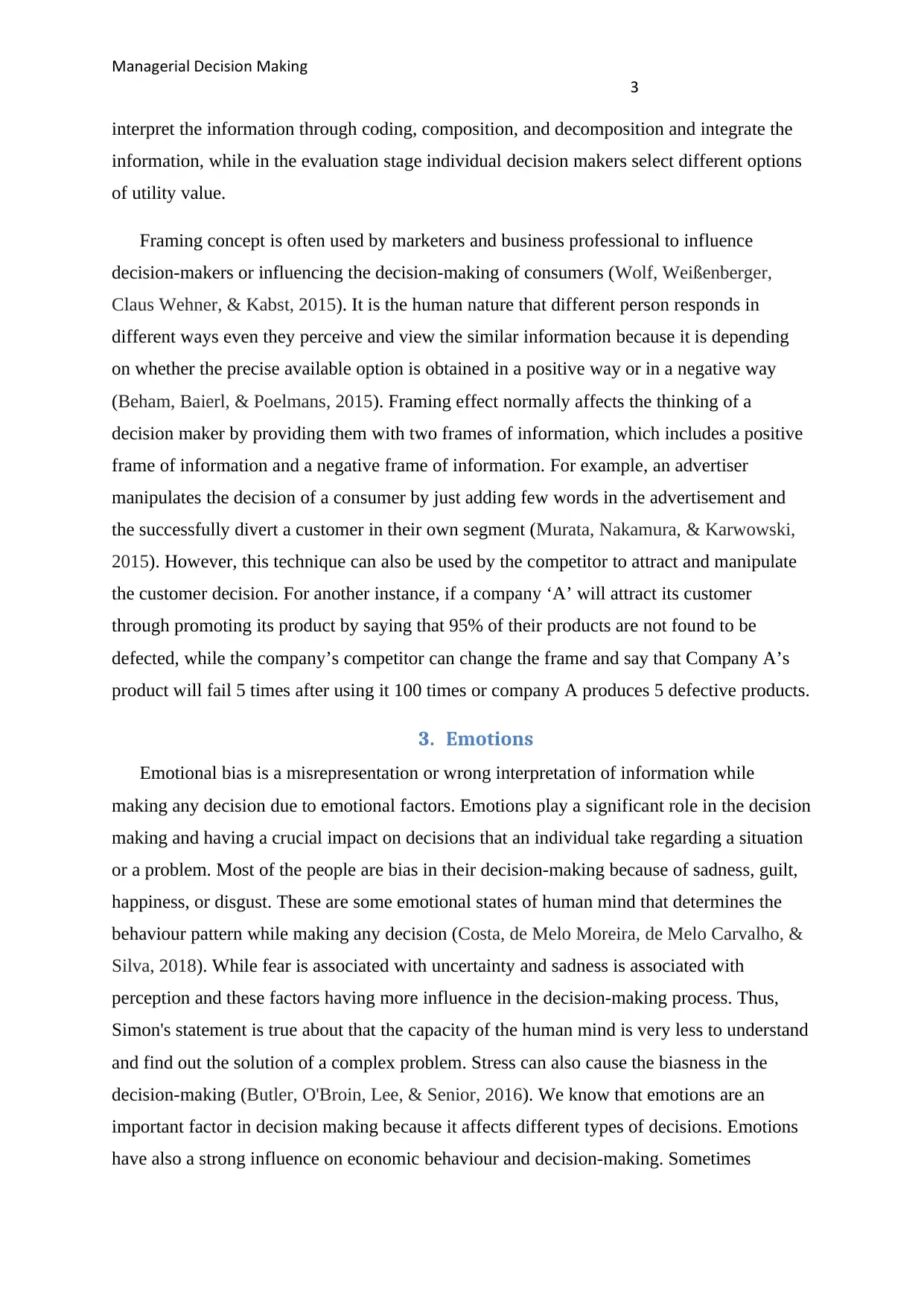
Managerial Decision Making
3
interpret the information through coding, composition, and decomposition and integrate the
information, while in the evaluation stage individual decision makers select different options
of utility value.
Framing concept is often used by marketers and business professional to influence
decision-makers or influencing the decision-making of consumers (Wolf, Weißenberger,
Claus Wehner, & Kabst, 2015). It is the human nature that different person responds in
different ways even they perceive and view the similar information because it is depending
on whether the precise available option is obtained in a positive way or in a negative way
(Beham, Baierl, & Poelmans, 2015). Framing effect normally affects the thinking of a
decision maker by providing them with two frames of information, which includes a positive
frame of information and a negative frame of information. For example, an advertiser
manipulates the decision of a consumer by just adding few words in the advertisement and
the successfully divert a customer in their own segment (Murata, Nakamura, & Karwowski,
2015). However, this technique can also be used by the competitor to attract and manipulate
the customer decision. For another instance, if a company ‘A’ will attract its customer
through promoting its product by saying that 95% of their products are not found to be
defected, while the company’s competitor can change the frame and say that Company A’s
product will fail 5 times after using it 100 times or company A produces 5 defective products.
3. Emotions
Emotional bias is a misrepresentation or wrong interpretation of information while
making any decision due to emotional factors. Emotions play a significant role in the decision
making and having a crucial impact on decisions that an individual take regarding a situation
or a problem. Most of the people are bias in their decision-making because of sadness, guilt,
happiness, or disgust. These are some emotional states of human mind that determines the
behaviour pattern while making any decision (Costa, de Melo Moreira, de Melo Carvalho, &
Silva, 2018). While fear is associated with uncertainty and sadness is associated with
perception and these factors having more influence in the decision-making process. Thus,
Simon's statement is true about that the capacity of the human mind is very less to understand
and find out the solution of a complex problem. Stress can also cause the biasness in the
decision-making (Butler, O'Broin, Lee, & Senior, 2016). We know that emotions are an
important factor in decision making because it affects different types of decisions. Emotions
have also a strong influence on economic behaviour and decision-making. Sometimes
3
interpret the information through coding, composition, and decomposition and integrate the
information, while in the evaluation stage individual decision makers select different options
of utility value.
Framing concept is often used by marketers and business professional to influence
decision-makers or influencing the decision-making of consumers (Wolf, Weißenberger,
Claus Wehner, & Kabst, 2015). It is the human nature that different person responds in
different ways even they perceive and view the similar information because it is depending
on whether the precise available option is obtained in a positive way or in a negative way
(Beham, Baierl, & Poelmans, 2015). Framing effect normally affects the thinking of a
decision maker by providing them with two frames of information, which includes a positive
frame of information and a negative frame of information. For example, an advertiser
manipulates the decision of a consumer by just adding few words in the advertisement and
the successfully divert a customer in their own segment (Murata, Nakamura, & Karwowski,
2015). However, this technique can also be used by the competitor to attract and manipulate
the customer decision. For another instance, if a company ‘A’ will attract its customer
through promoting its product by saying that 95% of their products are not found to be
defected, while the company’s competitor can change the frame and say that Company A’s
product will fail 5 times after using it 100 times or company A produces 5 defective products.
3. Emotions
Emotional bias is a misrepresentation or wrong interpretation of information while
making any decision due to emotional factors. Emotions play a significant role in the decision
making and having a crucial impact on decisions that an individual take regarding a situation
or a problem. Most of the people are bias in their decision-making because of sadness, guilt,
happiness, or disgust. These are some emotional states of human mind that determines the
behaviour pattern while making any decision (Costa, de Melo Moreira, de Melo Carvalho, &
Silva, 2018). While fear is associated with uncertainty and sadness is associated with
perception and these factors having more influence in the decision-making process. Thus,
Simon's statement is true about that the capacity of the human mind is very less to understand
and find out the solution of a complex problem. Stress can also cause the biasness in the
decision-making (Butler, O'Broin, Lee, & Senior, 2016). We know that emotions are an
important factor in decision making because it affects different types of decisions. Emotions
have also a strong influence on economic behaviour and decision-making. Sometimes
Paraphrase This Document
Need a fresh take? Get an instant paraphrase of this document with our AI Paraphraser
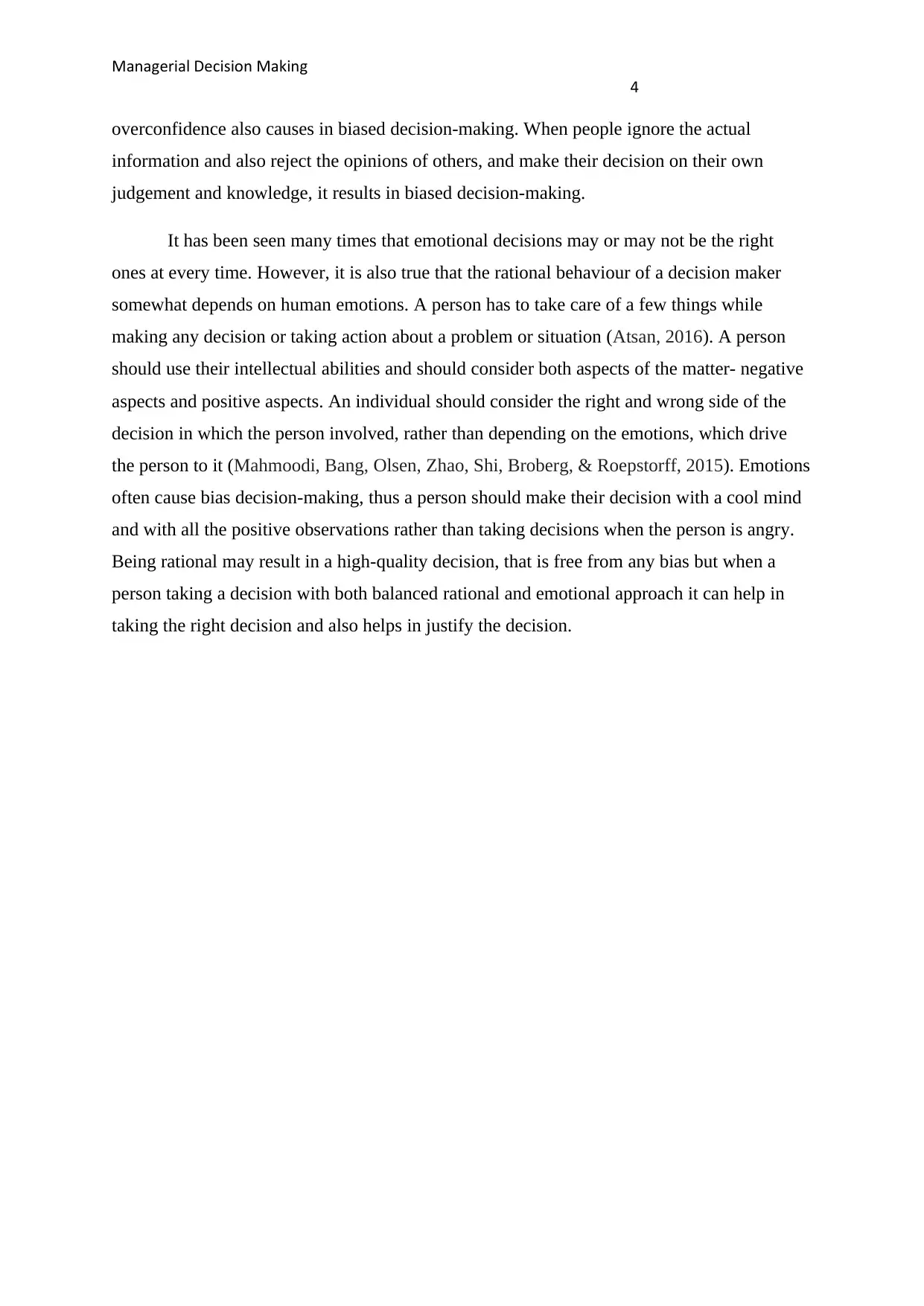
Managerial Decision Making
4
overconfidence also causes in biased decision-making. When people ignore the actual
information and also reject the opinions of others, and make their decision on their own
judgement and knowledge, it results in biased decision-making.
It has been seen many times that emotional decisions may or may not be the right
ones at every time. However, it is also true that the rational behaviour of a decision maker
somewhat depends on human emotions. A person has to take care of a few things while
making any decision or taking action about a problem or situation (Atsan, 2016). A person
should use their intellectual abilities and should consider both aspects of the matter- negative
aspects and positive aspects. An individual should consider the right and wrong side of the
decision in which the person involved, rather than depending on the emotions, which drive
the person to it (Mahmoodi, Bang, Olsen, Zhao, Shi, Broberg, & Roepstorff, 2015). Emotions
often cause bias decision-making, thus a person should make their decision with a cool mind
and with all the positive observations rather than taking decisions when the person is angry.
Being rational may result in a high-quality decision, that is free from any bias but when a
person taking a decision with both balanced rational and emotional approach it can help in
taking the right decision and also helps in justify the decision.
4
overconfidence also causes in biased decision-making. When people ignore the actual
information and also reject the opinions of others, and make their decision on their own
judgement and knowledge, it results in biased decision-making.
It has been seen many times that emotional decisions may or may not be the right
ones at every time. However, it is also true that the rational behaviour of a decision maker
somewhat depends on human emotions. A person has to take care of a few things while
making any decision or taking action about a problem or situation (Atsan, 2016). A person
should use their intellectual abilities and should consider both aspects of the matter- negative
aspects and positive aspects. An individual should consider the right and wrong side of the
decision in which the person involved, rather than depending on the emotions, which drive
the person to it (Mahmoodi, Bang, Olsen, Zhao, Shi, Broberg, & Roepstorff, 2015). Emotions
often cause bias decision-making, thus a person should make their decision with a cool mind
and with all the positive observations rather than taking decisions when the person is angry.
Being rational may result in a high-quality decision, that is free from any bias but when a
person taking a decision with both balanced rational and emotional approach it can help in
taking the right decision and also helps in justify the decision.

Managerial Decision Making
5
PART-2
Scenario- 1 (Bounded Awareness)
According to an article that is published in January 2006, in Harvard Business Review
Titled ‘Decision with blinders’ by Max H. Bazerman and Dolly Chugh, a US based company
Merck withdrew Vioxx (A pain relief drug) medicines from the US medicine market because
in September it was out of concern that this pain relief medicine causing heart attacks and
strokes. More than 100 million prescriptions already were filed in the USA alone and doctors
continuously prescribe this pain relief drug to the patients. However, the drug researchers
found that Vioxx has been causing more than 25000 heart attacks and strokes and more than
1000 were filed complain against the company (Pechmann & Catlin, 2016). However, the
evidence of the drug's hazards was publically available in 2000, when the New England
Journal of Medicine reported a complaint that if a person taking this medicine as many four
times, then they were experienced myocardial infarctions. After that in 2001, Merck is
showed to federal regulators and accept in its own report that 14.6% of Vioxx patients
suffered from cardiovascular troubles among them 2.5% were developed serious problems
(Jasper, Leenders, & O’Shannassy, 2017).
Therefore, here the problem is why the doctor prescribed this medicine; even the drug’s
risk had been published in 2000 and 2001. It means they overlooked this important
information while prescribed this medicine to the patients. Social sciences research has
shown that without knowing and realizing it, decision makers ignore certain critical
information (Bazerman & Sezer, 2016). It can also be said that doctors are also a human
being and they are like the rest of us who are imperfect information processors (Petersen &
Singhal, 2017). The bounded awareness occurs at various points in this scenario:
1. Doctors fail to see or seek out critical information that was needed to make sound
prescription to the patients.
2. If doctors were already aware of the information, they fail to use or share this
information with others that bounding the organisation's awareness.
This bias is identified by the complaint filed by people and other regulatory authority.
Even the doctors did not ask the patient as feedback about the medicine, or it might be
5
PART-2
Scenario- 1 (Bounded Awareness)
According to an article that is published in January 2006, in Harvard Business Review
Titled ‘Decision with blinders’ by Max H. Bazerman and Dolly Chugh, a US based company
Merck withdrew Vioxx (A pain relief drug) medicines from the US medicine market because
in September it was out of concern that this pain relief medicine causing heart attacks and
strokes. More than 100 million prescriptions already were filed in the USA alone and doctors
continuously prescribe this pain relief drug to the patients. However, the drug researchers
found that Vioxx has been causing more than 25000 heart attacks and strokes and more than
1000 were filed complain against the company (Pechmann & Catlin, 2016). However, the
evidence of the drug's hazards was publically available in 2000, when the New England
Journal of Medicine reported a complaint that if a person taking this medicine as many four
times, then they were experienced myocardial infarctions. After that in 2001, Merck is
showed to federal regulators and accept in its own report that 14.6% of Vioxx patients
suffered from cardiovascular troubles among them 2.5% were developed serious problems
(Jasper, Leenders, & O’Shannassy, 2017).
Therefore, here the problem is why the doctor prescribed this medicine; even the drug’s
risk had been published in 2000 and 2001. It means they overlooked this important
information while prescribed this medicine to the patients. Social sciences research has
shown that without knowing and realizing it, decision makers ignore certain critical
information (Bazerman & Sezer, 2016). It can also be said that doctors are also a human
being and they are like the rest of us who are imperfect information processors (Petersen &
Singhal, 2017). The bounded awareness occurs at various points in this scenario:
1. Doctors fail to see or seek out critical information that was needed to make sound
prescription to the patients.
2. If doctors were already aware of the information, they fail to use or share this
information with others that bounding the organisation's awareness.
This bias is identified by the complaint filed by people and other regulatory authority.
Even the doctors did not ask the patient as feedback about the medicine, or it might be
⊘ This is a preview!⊘
Do you want full access?
Subscribe today to unlock all pages.

Trusted by 1+ million students worldwide
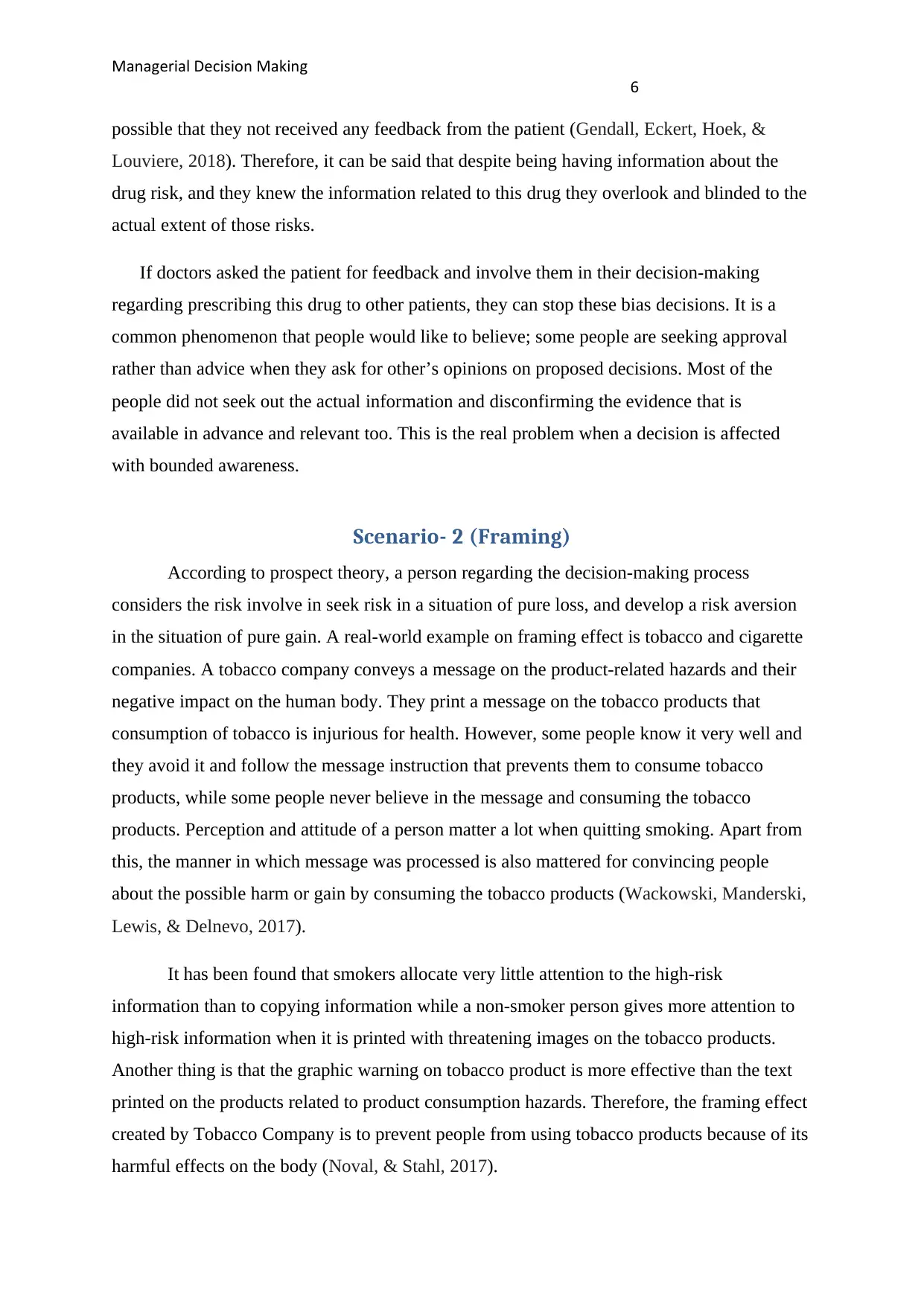
Managerial Decision Making
6
possible that they not received any feedback from the patient (Gendall, Eckert, Hoek, &
Louviere, 2018). Therefore, it can be said that despite being having information about the
drug risk, and they knew the information related to this drug they overlook and blinded to the
actual extent of those risks.
If doctors asked the patient for feedback and involve them in their decision-making
regarding prescribing this drug to other patients, they can stop these bias decisions. It is a
common phenomenon that people would like to believe; some people are seeking approval
rather than advice when they ask for other’s opinions on proposed decisions. Most of the
people did not seek out the actual information and disconfirming the evidence that is
available in advance and relevant too. This is the real problem when a decision is affected
with bounded awareness.
Scenario- 2 (Framing)
According to prospect theory, a person regarding the decision-making process
considers the risk involve in seek risk in a situation of pure loss, and develop a risk aversion
in the situation of pure gain. A real-world example on framing effect is tobacco and cigarette
companies. A tobacco company conveys a message on the product-related hazards and their
negative impact on the human body. They print a message on the tobacco products that
consumption of tobacco is injurious for health. However, some people know it very well and
they avoid it and follow the message instruction that prevents them to consume tobacco
products, while some people never believe in the message and consuming the tobacco
products. Perception and attitude of a person matter a lot when quitting smoking. Apart from
this, the manner in which message was processed is also mattered for convincing people
about the possible harm or gain by consuming the tobacco products (Wackowski, Manderski,
Lewis, & Delnevo, 2017).
It has been found that smokers allocate very little attention to the high-risk
information than to copying information while a non-smoker person gives more attention to
high-risk information when it is printed with threatening images on the tobacco products.
Another thing is that the graphic warning on tobacco product is more effective than the text
printed on the products related to product consumption hazards. Therefore, the framing effect
created by Tobacco Company is to prevent people from using tobacco products because of its
harmful effects on the body (Noval, & Stahl, 2017).
6
possible that they not received any feedback from the patient (Gendall, Eckert, Hoek, &
Louviere, 2018). Therefore, it can be said that despite being having information about the
drug risk, and they knew the information related to this drug they overlook and blinded to the
actual extent of those risks.
If doctors asked the patient for feedback and involve them in their decision-making
regarding prescribing this drug to other patients, they can stop these bias decisions. It is a
common phenomenon that people would like to believe; some people are seeking approval
rather than advice when they ask for other’s opinions on proposed decisions. Most of the
people did not seek out the actual information and disconfirming the evidence that is
available in advance and relevant too. This is the real problem when a decision is affected
with bounded awareness.
Scenario- 2 (Framing)
According to prospect theory, a person regarding the decision-making process
considers the risk involve in seek risk in a situation of pure loss, and develop a risk aversion
in the situation of pure gain. A real-world example on framing effect is tobacco and cigarette
companies. A tobacco company conveys a message on the product-related hazards and their
negative impact on the human body. They print a message on the tobacco products that
consumption of tobacco is injurious for health. However, some people know it very well and
they avoid it and follow the message instruction that prevents them to consume tobacco
products, while some people never believe in the message and consuming the tobacco
products. Perception and attitude of a person matter a lot when quitting smoking. Apart from
this, the manner in which message was processed is also mattered for convincing people
about the possible harm or gain by consuming the tobacco products (Wackowski, Manderski,
Lewis, & Delnevo, 2017).
It has been found that smokers allocate very little attention to the high-risk
information than to copying information while a non-smoker person gives more attention to
high-risk information when it is printed with threatening images on the tobacco products.
Another thing is that the graphic warning on tobacco product is more effective than the text
printed on the products related to product consumption hazards. Therefore, the framing effect
created by Tobacco Company is to prevent people from using tobacco products because of its
harmful effects on the body (Noval, & Stahl, 2017).
Paraphrase This Document
Need a fresh take? Get an instant paraphrase of this document with our AI Paraphraser
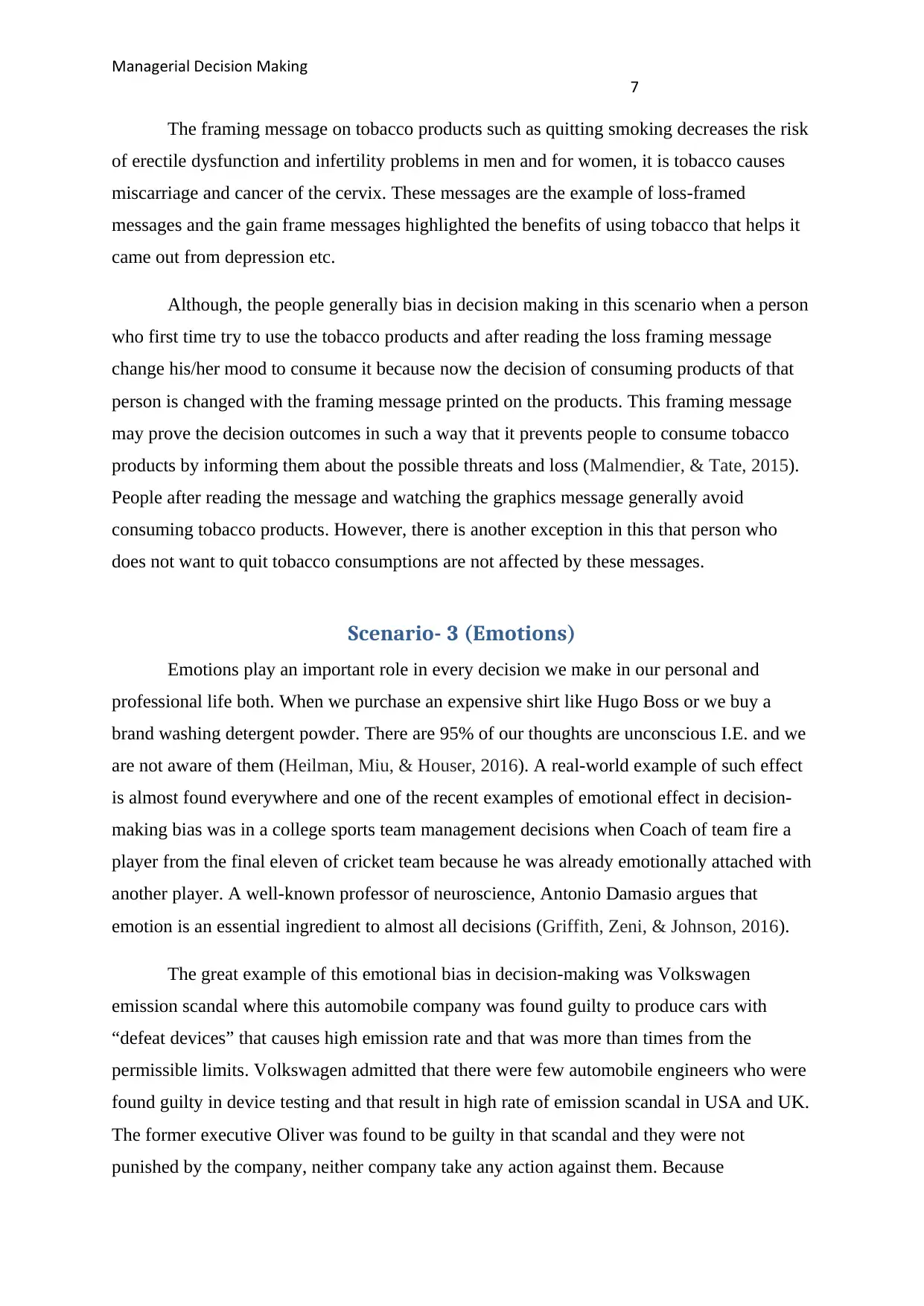
Managerial Decision Making
7
The framing message on tobacco products such as quitting smoking decreases the risk
of erectile dysfunction and infertility problems in men and for women, it is tobacco causes
miscarriage and cancer of the cervix. These messages are the example of loss-framed
messages and the gain frame messages highlighted the benefits of using tobacco that helps it
came out from depression etc.
Although, the people generally bias in decision making in this scenario when a person
who first time try to use the tobacco products and after reading the loss framing message
change his/her mood to consume it because now the decision of consuming products of that
person is changed with the framing message printed on the products. This framing message
may prove the decision outcomes in such a way that it prevents people to consume tobacco
products by informing them about the possible threats and loss (Malmendier, & Tate, 2015).
People after reading the message and watching the graphics message generally avoid
consuming tobacco products. However, there is another exception in this that person who
does not want to quit tobacco consumptions are not affected by these messages.
Scenario- 3 (Emotions)
Emotions play an important role in every decision we make in our personal and
professional life both. When we purchase an expensive shirt like Hugo Boss or we buy a
brand washing detergent powder. There are 95% of our thoughts are unconscious I.E. and we
are not aware of them (Heilman, Miu, & Houser, 2016). A real-world example of such effect
is almost found everywhere and one of the recent examples of emotional effect in decision-
making bias was in a college sports team management decisions when Coach of team fire a
player from the final eleven of cricket team because he was already emotionally attached with
another player. A well-known professor of neuroscience, Antonio Damasio argues that
emotion is an essential ingredient to almost all decisions (Griffith, Zeni, & Johnson, 2016).
The great example of this emotional bias in decision-making was Volkswagen
emission scandal where this automobile company was found guilty to produce cars with
“defeat devices” that causes high emission rate and that was more than times from the
permissible limits. Volkswagen admitted that there were few automobile engineers who were
found guilty in device testing and that result in high rate of emission scandal in USA and UK.
The former executive Oliver was found to be guilty in that scandal and they were not
punished by the company, neither company take any action against them. Because
7
The framing message on tobacco products such as quitting smoking decreases the risk
of erectile dysfunction and infertility problems in men and for women, it is tobacco causes
miscarriage and cancer of the cervix. These messages are the example of loss-framed
messages and the gain frame messages highlighted the benefits of using tobacco that helps it
came out from depression etc.
Although, the people generally bias in decision making in this scenario when a person
who first time try to use the tobacco products and after reading the loss framing message
change his/her mood to consume it because now the decision of consuming products of that
person is changed with the framing message printed on the products. This framing message
may prove the decision outcomes in such a way that it prevents people to consume tobacco
products by informing them about the possible threats and loss (Malmendier, & Tate, 2015).
People after reading the message and watching the graphics message generally avoid
consuming tobacco products. However, there is another exception in this that person who
does not want to quit tobacco consumptions are not affected by these messages.
Scenario- 3 (Emotions)
Emotions play an important role in every decision we make in our personal and
professional life both. When we purchase an expensive shirt like Hugo Boss or we buy a
brand washing detergent powder. There are 95% of our thoughts are unconscious I.E. and we
are not aware of them (Heilman, Miu, & Houser, 2016). A real-world example of such effect
is almost found everywhere and one of the recent examples of emotional effect in decision-
making bias was in a college sports team management decisions when Coach of team fire a
player from the final eleven of cricket team because he was already emotionally attached with
another player. A well-known professor of neuroscience, Antonio Damasio argues that
emotion is an essential ingredient to almost all decisions (Griffith, Zeni, & Johnson, 2016).
The great example of this emotional bias in decision-making was Volkswagen
emission scandal where this automobile company was found guilty to produce cars with
“defeat devices” that causes high emission rate and that was more than times from the
permissible limits. Volkswagen admitted that there were few automobile engineers who were
found guilty in device testing and that result in high rate of emission scandal in USA and UK.
The former executive Oliver was found to be guilty in that scandal and they were not
punished by the company, neither company take any action against them. Because

Managerial Decision Making
8
somewhere, the top executives of the company favour their employees and not disclose this
matter in public even they know the situation (Koch, D'mello, & Sackett, 2015). The
emotional attachment of the company and fear to caught by the regulatory bodies force them
to take unethical decision making regarding the manufacturing of such care, which is
polluting the air with excessive emission.
If the company was not emotionally taken the decision to continue the manufacturing
of cars that were inbuilt faulty engines that generate a high level of emission, they will not be
caught by the pollution control regulatory bodies of USA (Sezer, Zhang, Gino, & Bazerman,
2016). Volkswagen emission scandal is known as one of the biggest fraud in US history.
This scandal was prevented by the company if they continuously check their engine
testing process. The company trust and emotionally taken a decision about their engine
testing process and even after, they continue with the manufacturing when most of the top
executives know the exact scenario. Company if taken an ethical decision and not focus on
the emotional attachment in decision making regarding the manufacturing of new cars with
defective engines, they can stop this scandal (WILSON, 2016). Thus, the emotional effect in
decision-making causes bias with the rest of the world and with customers of Volkswagen
when they sold them cars with defective car engines that were highly involved in emission
rate in USA and rest of the world.
8
somewhere, the top executives of the company favour their employees and not disclose this
matter in public even they know the situation (Koch, D'mello, & Sackett, 2015). The
emotional attachment of the company and fear to caught by the regulatory bodies force them
to take unethical decision making regarding the manufacturing of such care, which is
polluting the air with excessive emission.
If the company was not emotionally taken the decision to continue the manufacturing
of cars that were inbuilt faulty engines that generate a high level of emission, they will not be
caught by the pollution control regulatory bodies of USA (Sezer, Zhang, Gino, & Bazerman,
2016). Volkswagen emission scandal is known as one of the biggest fraud in US history.
This scandal was prevented by the company if they continuously check their engine
testing process. The company trust and emotionally taken a decision about their engine
testing process and even after, they continue with the manufacturing when most of the top
executives know the exact scenario. Company if taken an ethical decision and not focus on
the emotional attachment in decision making regarding the manufacturing of new cars with
defective engines, they can stop this scandal (WILSON, 2016). Thus, the emotional effect in
decision-making causes bias with the rest of the world and with customers of Volkswagen
when they sold them cars with defective car engines that were highly involved in emission
rate in USA and rest of the world.
⊘ This is a preview!⊘
Do you want full access?
Subscribe today to unlock all pages.

Trusted by 1+ million students worldwide
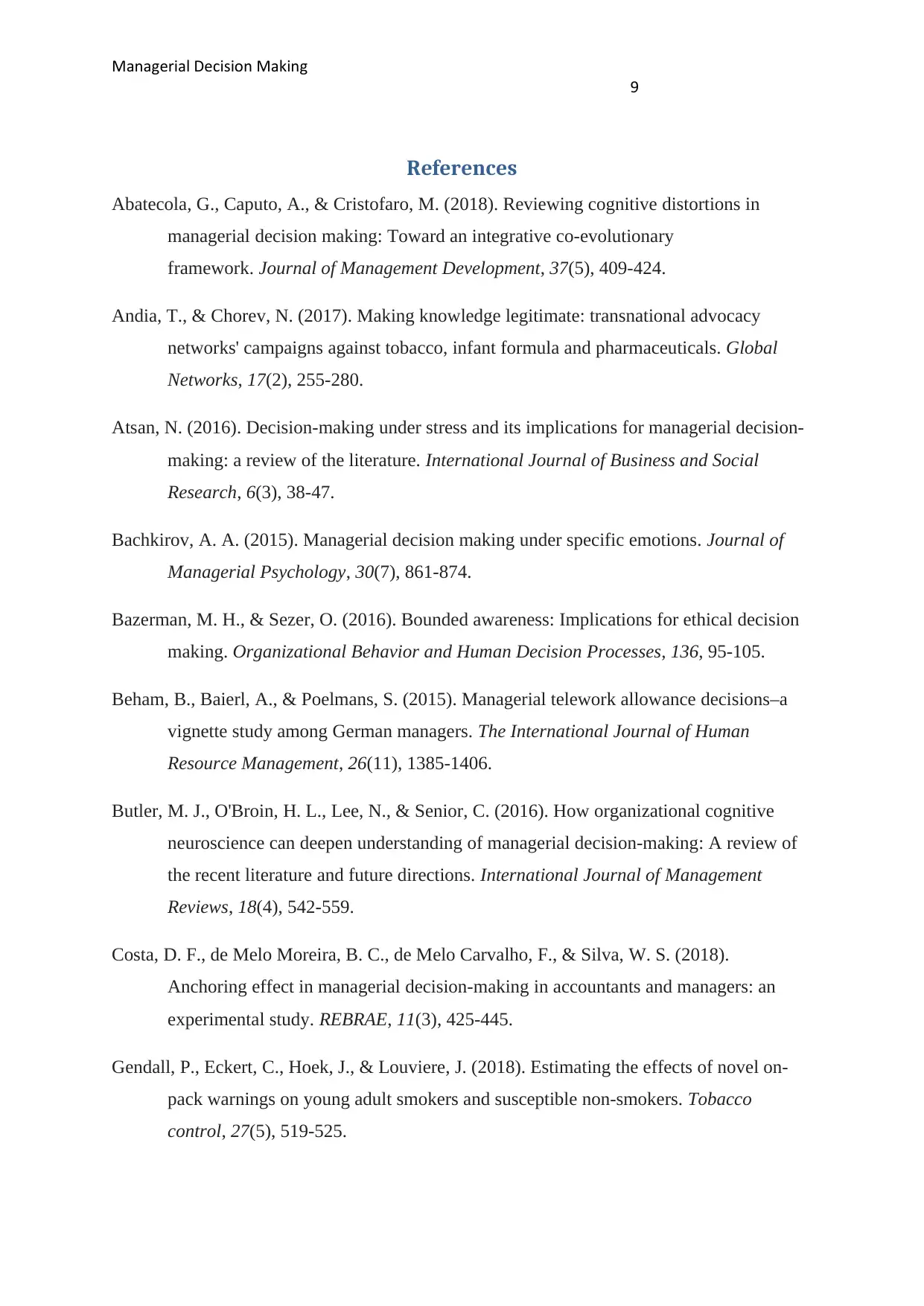
Managerial Decision Making
9
References
Abatecola, G., Caputo, A., & Cristofaro, M. (2018). Reviewing cognitive distortions in
managerial decision making: Toward an integrative co-evolutionary
framework. Journal of Management Development, 37(5), 409-424.
Andia, T., & Chorev, N. (2017). Making knowledge legitimate: transnational advocacy
networks' campaigns against tobacco, infant formula and pharmaceuticals. Global
Networks, 17(2), 255-280.
Atsan, N. (2016). Decision-making under stress and its implications for managerial decision-
making: a review of the literature. International Journal of Business and Social
Research, 6(3), 38-47.
Bachkirov, A. A. (2015). Managerial decision making under specific emotions. Journal of
Managerial Psychology, 30(7), 861-874.
Bazerman, M. H., & Sezer, O. (2016). Bounded awareness: Implications for ethical decision
making. Organizational Behavior and Human Decision Processes, 136, 95-105.
Beham, B., Baierl, A., & Poelmans, S. (2015). Managerial telework allowance decisions–a
vignette study among German managers. The International Journal of Human
Resource Management, 26(11), 1385-1406.
Butler, M. J., O'Broin, H. L., Lee, N., & Senior, C. (2016). How organizational cognitive
neuroscience can deepen understanding of managerial decision‐making: A review of
the recent literature and future directions. International Journal of Management
Reviews, 18(4), 542-559.
Costa, D. F., de Melo Moreira, B. C., de Melo Carvalho, F., & Silva, W. S. (2018).
Anchoring effect in managerial decision-making in accountants and managers: an
experimental study. REBRAE, 11(3), 425-445.
Gendall, P., Eckert, C., Hoek, J., & Louviere, J. (2018). Estimating the effects of novel on-
pack warnings on young adult smokers and susceptible non-smokers. Tobacco
control, 27(5), 519-525.
9
References
Abatecola, G., Caputo, A., & Cristofaro, M. (2018). Reviewing cognitive distortions in
managerial decision making: Toward an integrative co-evolutionary
framework. Journal of Management Development, 37(5), 409-424.
Andia, T., & Chorev, N. (2017). Making knowledge legitimate: transnational advocacy
networks' campaigns against tobacco, infant formula and pharmaceuticals. Global
Networks, 17(2), 255-280.
Atsan, N. (2016). Decision-making under stress and its implications for managerial decision-
making: a review of the literature. International Journal of Business and Social
Research, 6(3), 38-47.
Bachkirov, A. A. (2015). Managerial decision making under specific emotions. Journal of
Managerial Psychology, 30(7), 861-874.
Bazerman, M. H., & Sezer, O. (2016). Bounded awareness: Implications for ethical decision
making. Organizational Behavior and Human Decision Processes, 136, 95-105.
Beham, B., Baierl, A., & Poelmans, S. (2015). Managerial telework allowance decisions–a
vignette study among German managers. The International Journal of Human
Resource Management, 26(11), 1385-1406.
Butler, M. J., O'Broin, H. L., Lee, N., & Senior, C. (2016). How organizational cognitive
neuroscience can deepen understanding of managerial decision‐making: A review of
the recent literature and future directions. International Journal of Management
Reviews, 18(4), 542-559.
Costa, D. F., de Melo Moreira, B. C., de Melo Carvalho, F., & Silva, W. S. (2018).
Anchoring effect in managerial decision-making in accountants and managers: an
experimental study. REBRAE, 11(3), 425-445.
Gendall, P., Eckert, C., Hoek, J., & Louviere, J. (2018). Estimating the effects of novel on-
pack warnings on young adult smokers and susceptible non-smokers. Tobacco
control, 27(5), 519-525.
Paraphrase This Document
Need a fresh take? Get an instant paraphrase of this document with our AI Paraphraser
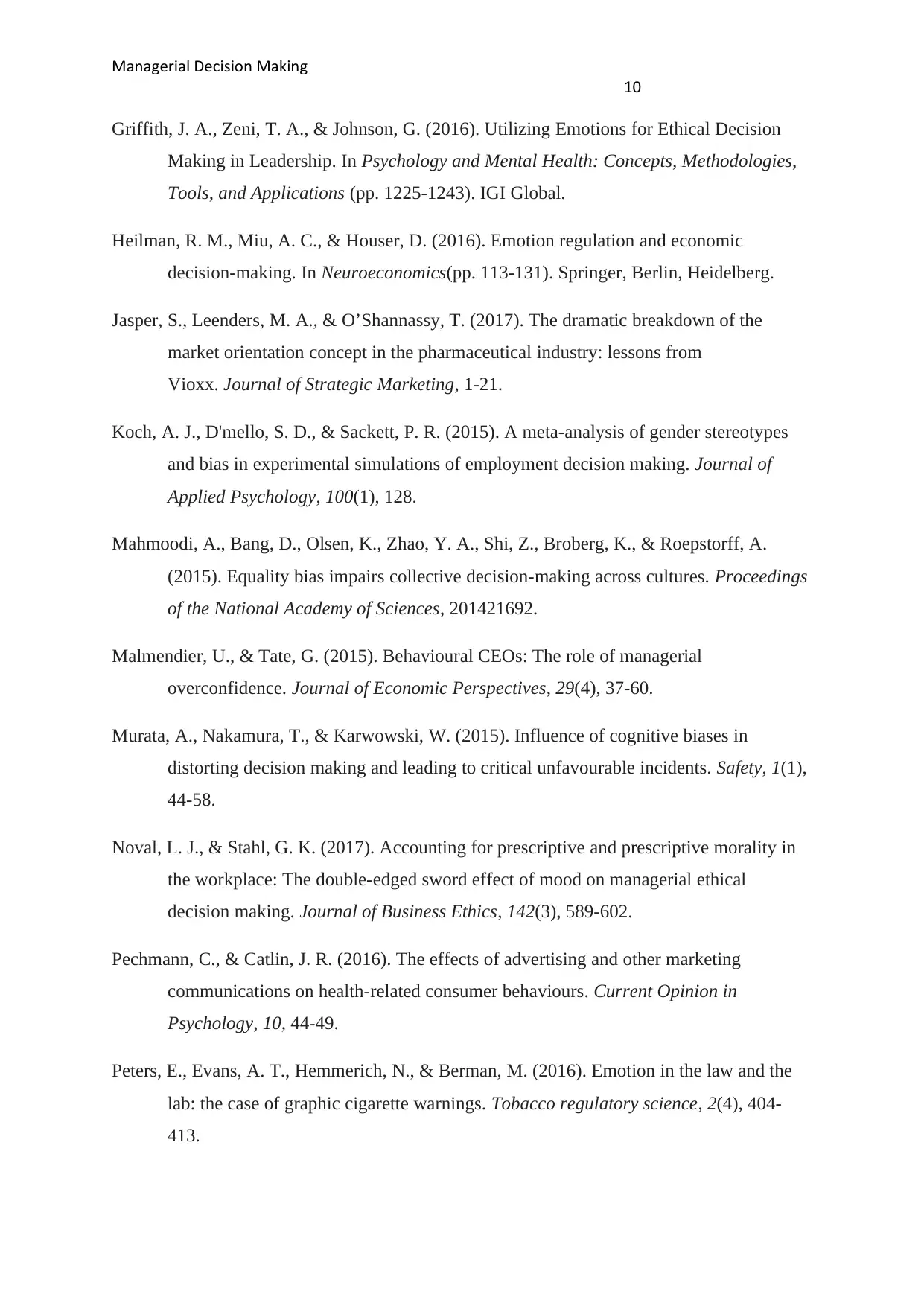
Managerial Decision Making
10
Griffith, J. A., Zeni, T. A., & Johnson, G. (2016). Utilizing Emotions for Ethical Decision
Making in Leadership. In Psychology and Mental Health: Concepts, Methodologies,
Tools, and Applications (pp. 1225-1243). IGI Global.
Heilman, R. M., Miu, A. C., & Houser, D. (2016). Emotion regulation and economic
decision-making. In Neuroeconomics(pp. 113-131). Springer, Berlin, Heidelberg.
Jasper, S., Leenders, M. A., & O’Shannassy, T. (2017). The dramatic breakdown of the
market orientation concept in the pharmaceutical industry: lessons from
Vioxx. Journal of Strategic Marketing, 1-21.
Koch, A. J., D'mello, S. D., & Sackett, P. R. (2015). A meta-analysis of gender stereotypes
and bias in experimental simulations of employment decision making. Journal of
Applied Psychology, 100(1), 128.
Mahmoodi, A., Bang, D., Olsen, K., Zhao, Y. A., Shi, Z., Broberg, K., & Roepstorff, A.
(2015). Equality bias impairs collective decision-making across cultures. Proceedings
of the National Academy of Sciences, 201421692.
Malmendier, U., & Tate, G. (2015). Behavioural CEOs: The role of managerial
overconfidence. Journal of Economic Perspectives, 29(4), 37-60.
Murata, A., Nakamura, T., & Karwowski, W. (2015). Influence of cognitive biases in
distorting decision making and leading to critical unfavourable incidents. Safety, 1(1),
44-58.
Noval, L. J., & Stahl, G. K. (2017). Accounting for prescriptive and prescriptive morality in
the workplace: The double-edged sword effect of mood on managerial ethical
decision making. Journal of Business Ethics, 142(3), 589-602.
Pechmann, C., & Catlin, J. R. (2016). The effects of advertising and other marketing
communications on health-related consumer behaviours. Current Opinion in
Psychology, 10, 44-49.
Peters, E., Evans, A. T., Hemmerich, N., & Berman, M. (2016). Emotion in the law and the
lab: the case of graphic cigarette warnings. Tobacco regulatory science, 2(4), 404-
413.
10
Griffith, J. A., Zeni, T. A., & Johnson, G. (2016). Utilizing Emotions for Ethical Decision
Making in Leadership. In Psychology and Mental Health: Concepts, Methodologies,
Tools, and Applications (pp. 1225-1243). IGI Global.
Heilman, R. M., Miu, A. C., & Houser, D. (2016). Emotion regulation and economic
decision-making. In Neuroeconomics(pp. 113-131). Springer, Berlin, Heidelberg.
Jasper, S., Leenders, M. A., & O’Shannassy, T. (2017). The dramatic breakdown of the
market orientation concept in the pharmaceutical industry: lessons from
Vioxx. Journal of Strategic Marketing, 1-21.
Koch, A. J., D'mello, S. D., & Sackett, P. R. (2015). A meta-analysis of gender stereotypes
and bias in experimental simulations of employment decision making. Journal of
Applied Psychology, 100(1), 128.
Mahmoodi, A., Bang, D., Olsen, K., Zhao, Y. A., Shi, Z., Broberg, K., & Roepstorff, A.
(2015). Equality bias impairs collective decision-making across cultures. Proceedings
of the National Academy of Sciences, 201421692.
Malmendier, U., & Tate, G. (2015). Behavioural CEOs: The role of managerial
overconfidence. Journal of Economic Perspectives, 29(4), 37-60.
Murata, A., Nakamura, T., & Karwowski, W. (2015). Influence of cognitive biases in
distorting decision making and leading to critical unfavourable incidents. Safety, 1(1),
44-58.
Noval, L. J., & Stahl, G. K. (2017). Accounting for prescriptive and prescriptive morality in
the workplace: The double-edged sword effect of mood on managerial ethical
decision making. Journal of Business Ethics, 142(3), 589-602.
Pechmann, C., & Catlin, J. R. (2016). The effects of advertising and other marketing
communications on health-related consumer behaviours. Current Opinion in
Psychology, 10, 44-49.
Peters, E., Evans, A. T., Hemmerich, N., & Berman, M. (2016). Emotion in the law and the
lab: the case of graphic cigarette warnings. Tobacco regulatory science, 2(4), 404-
413.
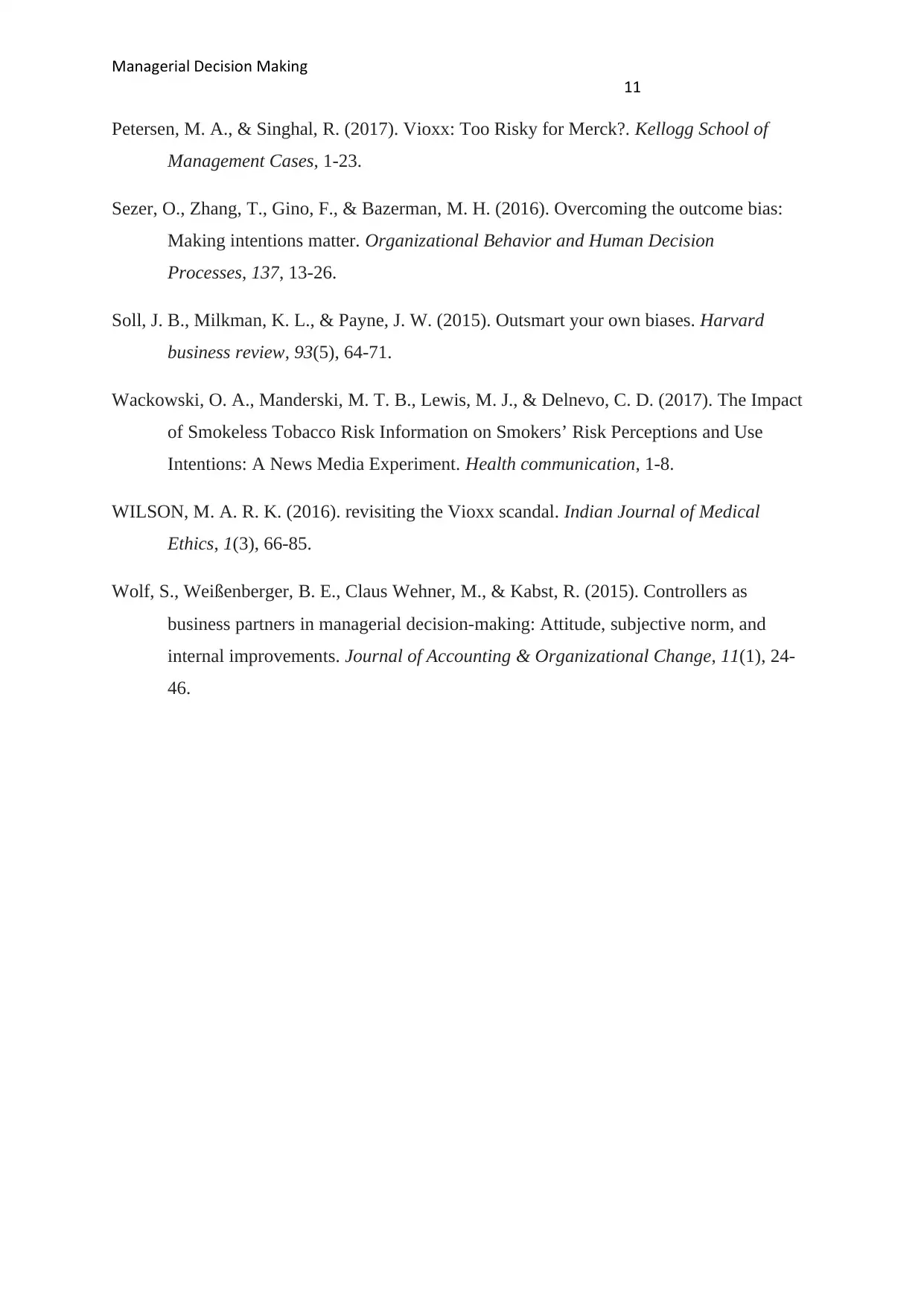
Managerial Decision Making
11
Petersen, M. A., & Singhal, R. (2017). Vioxx: Too Risky for Merck?. Kellogg School of
Management Cases, 1-23.
Sezer, O., Zhang, T., Gino, F., & Bazerman, M. H. (2016). Overcoming the outcome bias:
Making intentions matter. Organizational Behavior and Human Decision
Processes, 137, 13-26.
Soll, J. B., Milkman, K. L., & Payne, J. W. (2015). Outsmart your own biases. Harvard
business review, 93(5), 64-71.
Wackowski, O. A., Manderski, M. T. B., Lewis, M. J., & Delnevo, C. D. (2017). The Impact
of Smokeless Tobacco Risk Information on Smokers’ Risk Perceptions and Use
Intentions: A News Media Experiment. Health communication, 1-8.
WILSON, M. A. R. K. (2016). revisiting the Vioxx scandal. Indian Journal of Medical
Ethics, 1(3), 66-85.
Wolf, S., Weißenberger, B. E., Claus Wehner, M., & Kabst, R. (2015). Controllers as
business partners in managerial decision-making: Attitude, subjective norm, and
internal improvements. Journal of Accounting & Organizational Change, 11(1), 24-
46.
11
Petersen, M. A., & Singhal, R. (2017). Vioxx: Too Risky for Merck?. Kellogg School of
Management Cases, 1-23.
Sezer, O., Zhang, T., Gino, F., & Bazerman, M. H. (2016). Overcoming the outcome bias:
Making intentions matter. Organizational Behavior and Human Decision
Processes, 137, 13-26.
Soll, J. B., Milkman, K. L., & Payne, J. W. (2015). Outsmart your own biases. Harvard
business review, 93(5), 64-71.
Wackowski, O. A., Manderski, M. T. B., Lewis, M. J., & Delnevo, C. D. (2017). The Impact
of Smokeless Tobacco Risk Information on Smokers’ Risk Perceptions and Use
Intentions: A News Media Experiment. Health communication, 1-8.
WILSON, M. A. R. K. (2016). revisiting the Vioxx scandal. Indian Journal of Medical
Ethics, 1(3), 66-85.
Wolf, S., Weißenberger, B. E., Claus Wehner, M., & Kabst, R. (2015). Controllers as
business partners in managerial decision-making: Attitude, subjective norm, and
internal improvements. Journal of Accounting & Organizational Change, 11(1), 24-
46.
⊘ This is a preview!⊘
Do you want full access?
Subscribe today to unlock all pages.

Trusted by 1+ million students worldwide
1 out of 12
Related Documents
Your All-in-One AI-Powered Toolkit for Academic Success.
+13062052269
info@desklib.com
Available 24*7 on WhatsApp / Email
![[object Object]](/_next/static/media/star-bottom.7253800d.svg)
Unlock your academic potential
Copyright © 2020–2025 A2Z Services. All Rights Reserved. Developed and managed by ZUCOL.





